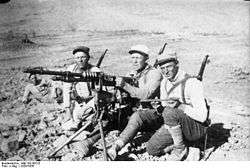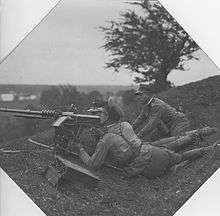Hotchkiss M1914 machine gun
| Hotchkiss M1914 | |
|---|---|
 Hotchkiss Mle 14 | |
| Type | Medium machine gun |
| Place of origin | France |
| Service history | |
| In service | 1914–1960s |
| Used by | See Users |
| Wars |
Mexican Revolution World War I Polish–Soviet War World War II Constitutionalist Revolution Second Italo-Ethiopian War Spanish Civil War Second Sino-Japanese War First Indochina War Algerian War |
| Production history | |
| Designer |
A. Odkolek von Augeza Laurence V. Benét Henri Mercié. |
| Designed | 1897 (M1897), 1900 (M1900) |
| Produced | 1914–20 (M1914) |
| Number built | over 65,000 |
| Variants |
M1897 M1900 M1914 |
| Specifications | |
| Weight | 53 lb 11 oz (24.4 kg) |
| Length | 1390 mm (55 in) |
| Barrel length | 787 mm (31 in) |
|
| |
| Cartridge |
8×50R Lebel 7×57mm Mauser 6.5×50mmSR Arisaka 11 mm Gras 6.5×55mm |
| Caliber | 8 mm |
| Action | gas-actuated |
| Rate of fire | 450-600 round/min |
| Muzzle velocity | 2,375 ft/s (724 m/s) |
| Feed system |
30 round strip articulated metal belt |

The Mle 1914 Hotchkiss machine gun chambered for the 8mm Lebel cartridge became the standard machine gun of the French Army during World War I. It was manufactured by the French arms company Hotchkiss et Cie, which had been established in the 1860s by American industrialist Benjamin B. Hotchkiss. The gas-actuated Hotchkiss system was first formulated in 1895 by Odkolek von Ujezda and improved into its final form by Hotchkiss armament engineers Laurence Benét and Henri Mercié.
The Mle 1914 was the last version of a series of nearly identical Hotchkiss designs : the Mle 1897, Mle 1900 and the Mle 1908. The Hotchkiss Mle 1914 became the French infantry standard in late 1917, replacing the unreliable St. Étienne Mle 1907. The American Expeditionary Forces (AEF) in France also purchased 7,000 Mle 1914 Hotchkiss machine guns in 8mm Lebel, and used them extensively at the front in 1917 and 1918. Hotchkiss heavy machine guns, some being of earlier types, were also used in combat by Japan, Chile, Mexico, Spain, Belgium, Brazil and Poland.
The Hotchkiss machine gun, a sturdy and reliable weapon, remained in active service with the French army until the early 1940s. By the end of 1918, 47,000 Hotchkiss machine guns had already been delivered to the French army alone. If one includes all the international sales, the grand total of all Hotchkiss machine guns sold by the manufacturer in various calibers is well in excess of 100,000 units.
History and design
%2C_MDLA.jpg)
The Hotchkiss was based on a design by Captain Baron Adolf Odkolek von Ujezda of Vienna. The patents had been purchased in 1893 by the firm of Benjamin Hotchkiss, based in Saint-Denis, near Paris. Benjamin Hotchkiss was no longer alive at the time of the purchase, but the Odkolek design was further developed and greatly improved under the direction of American-born Laurence Vincent Benét (1863–1948) with the assistance of Henri Albert Mercié. After trials that began in 1895, development issues were resolved leading to the initial purchase of the Hotchkiss gun by the French Military in 1897. In 1898 an export model was also offered for international sales by Hotchkiss. With some useful changes, such as the addition of five cooling radiator rings on the barrel, the same basic design led to the M1900, and later to the M1914 (with minor improvements that were added since 1908). In the meantime adoption of the St. Étienne Mle 1907 (a French government arsenal product ) to equip the infantry went through in 1908. Nevertheless, Hotchkiss machine guns were also purchased by the French military for use in overseas colonies and by mountain troops in the Alps. By the 1916, during World War I, French line infantry, still equipped with the unsatisfactory Saint-Etienne, convinced General Petain that it needed the more reliable Hotchkiss. It got its wish and French infantry divisions became progressively outfitted with the Hotchkiss gun in late 1917 and early 1918.
The Hotchkiss machine gun was gas actuated and air-cooled, in contrast to the Maxim gun which was recoil operated and water-cooled. The Hotchkiss machine gun barrel features five large annular rings which materially assisted natural cooling and retarded overheating. The gas cylinder under the barrel features a regulator piston which can be adjusted to the normal rate of fire of 450 rounds per minute. The Hotchkiss machine gun itself ( excluding the tripod) has only 32 parts ( US War Department Handbook of the Hotchkiss Machine Gun, Model of 1914 ) including four coil springs and no screws or pins whatsoever. All parts of the gun are constructed in such a manner that it is impossible to assemble them improperly. The Hotchkiss fired from an open bolt, like almost all modern machine guns in order to avoid "cook-offs" . Although the Hotchkiss machine gun was easy to feed continuously with a three-man team, each individual strip held only 24 rounds of 8mm Lebel ammunition. Each empty feed strip was ejected automatically after its last round had been fired, leaving the bolt open in the rear position. Then introducing a new loaded strip into the gun triggered the release forward of the bolt and firing resumed. The Hotchkiss strips performed well with a three-man crew, but their capacity was too small for a single gunner firing from the inside of a tank. This led to the adoption of a 250-round articulated metal belt in 1917. It was widely used in all French tanks of the period and in some military airplanes .
Beginning in 1900, two basic tripod types were used prior to World War I, when the final and most effective third Hotchkiss tripod model (the Mle 1916) became adopted and widely distributed. A tripod that could be used for both the Hotchkiss and the St. Etienne machine guns was issued in 1915: the so-called "Omnibus Tripod". The French Hotchkiss had a rate of fire of approximately 450 rounds per minute of 8 mm Lebel ammunition, and a maximum effective range of 3,800 m (4,150 yd) with the "Balle D" bullet. Fire for effect was usually in successive bursts of 8 to 10 rounds. The gun could sustain continuous firing of about 120 aimed shots per minute almost indefinitely ( US War Department Handbook,1917 ) except for occasional barrel changes (during continuous fire, approximately every 1,000 rounds) which were quick and easy to perform with a special wrench. The barrel could attain a temperature of about 400 °C, at which temperature it would be dark red in color. At this point the barrel dissipated heat as fast as it was generated. This only occurred after long continuous firing in a combat emergency situation. The most common complaint about the Hotchkiss was its weight: the gun and tripod weighed a total of 110 pounds. There were also complaints concerning the tripods, particularly the "Omnibus" tripods, which were perceived as too high above ground and too heavy.
Service Use
World War I. France and USA

The principal user of the Mle 1914 Hotchkiss machine gun was French infantry during World War I and in 1939-40. The Hotchkiss company delivered 47,000 Mle 1914 machine guns to the French Army between 1914 and the end of 1918. Several hundred were in the 11mm Gras caliber for anti balloons use since it was the smallest caliber to be able to receive an incendiary bullet but all the others were in 8mm Lebel. The second-largest user of the Hotchkiss gun was the American Expeditionary Forces in France between 1917 and 1918. The U.S. purchased and used in combat 7,000 Mle 1914 Hotchkiss machine guns, also in 8mm Lebel.
Japanese version
Hotchkiss machine guns in 6.5 mm caliber were successfully deployed by Japan. The production of the gun was licensed to Japan to become the Type 3 Heavy Machine Gun, but the cartridge was the standard Japanese 6.5x50mm Arisaka rather than the original 8 mm ammunition. The Type 92 Heavy Machine Gun, a scaled-up Type 3 chambered for 7.7mm, was also based on the Hotchkiss design.
In China
In 1930 to 1935, the Chinese Nationalist Government bought 1,192 Hotchkiss M1914 machine guns from France. The Chinese also copied this gun and used the German 7.92×57mm Mauser. After the Second Sino-Japanese War broke out in 1937, the Chinese also ordered 1,300 guns, but only 300 guns were delivered.
In Poland

Poland received the first M1914 Hotchkiss machine guns together with the arrival of the Blue Army in 1919. During and after the Polish-Bolshevik War the Polish Army bought additional pieces in France and by 1936 there were 2620 pieces in Polish service (used under the ckm wz. 14 - "HMG Mk. 1914"). In mid-1920s the army ordered 1250 pieces of a slightly modified version rechambered to the standard 7.92×57mm Mauser calibre. However, the army found that the newly delivered machine guns, dubbed ckm wz.25 Hotchkiss were substandard: the barrel was prone to overheating and the accuracy was found to be too low.
Instead of trying to renegotiate the contract with Hotchkiss, the Polish General Staff ordered large numbers of Ckm wz.30 machine gun instead and both 1914 and 1925 models of Hotchkiss were withdrawn from infantry service by 1936. Some were sold abroad, many were modified to arm the Renault FT tanks, TK-3 and TKS tankettes and Samochód pancerny wz. 29 and wz. 34 armoured cars. During the Invasion of Poland of 1939 the wz. 25 and wz. 14 machine guns were nevertheless used in combat by some Polish infantry units, notably the Border Defence Corps and National Defense.
Other countries
Hotchkiss machine guns firing 7 mm Mauser ammunition equipped both sides (Governmental forces and Pancho Villa's) during the Mexican Revolution (1910–1920). The same type of 7 mm Hotchkiss machine gun, built under license in Spain where it was the standard medium machine gun, was widely used by the conflicting parties involved in the Spanish Civil War (1930's). Furthermore, the Mle 1914 Hotchkiss in 8 mm Lebel was mounted in all French tanks and armored cars of World War I. Some examples of tanks that used the Mle 1914 Hotchkiss include the Schneider CA1, Saint-Chamond, Renault FT and Char 2C. Conversely, British tanks and armored cars were fitted with the British version, the distinctly different Mle 1909 light Hotchkiss (a.k.a. the "Benét–Mercié"). A recently published series of modern firing tests with vintage machine guns summarizes the Mle 1914 Hotchkiss as being: "A heavy and rock-steady combination of gun and tripod, the world's first efficient air cooled machine gun is admirably reliable and accurate" (Robert Bruce, 1997). These qualities provided the French military with an excuse to keep the Hotchkiss in active service far beyond its point of obsolescence and into World War II. The last recorded uses of the Hotchkiss were in Indochina and Algeria, after World War II, to defend outposts in static positions. The World War II Hellenic Greek Army employed a modified Hotchkiss machine gun known as the Hotchkiss M1926, with an increased rate of fire of 450RPM.
Users
 Afghanistan
Afghanistan.svg.png) Belgium
Belgium Chile
Chile.svg.png) Ethiopian Empire
Ethiopian Empire.svg.png) Kingdom of Greece
Kingdom of Greece_crowned.svg.png) Kingdom of Italy
Kingdom of Italy.svg.png) Brazil
Brazil France
France
 Republic of China
Republic of China.svg.png) Empire of Japan: designated the Type 3 heavy machine gun
Empire of Japan: designated the Type 3 heavy machine gun.png) Mexico
Mexico Norway
Norway Peru
Peru Poland
Poland Romania[1]
Romania[1] Soviet Russia: several Red Army units used Hotchkiss M1914 during Russian Civil War[2]
Soviet Russia: several Red Army units used Hotchkiss M1914 during Russian Civil War[2].svg.png) Spain
Spain Sweden
Sweden Turkey
Turkey United States
United States
References
- ↑ http://www.culture.gouv.fr/public/mistral/memoire_fr?ACTION=RETROUVER&FIELD_98=AUTP&VALUE_98=%20Romania&NUMBER=27&GRP=13&REQ=%28%28Romania%29%20%3aAUTP%20%29&USRNAME=nobody&USRPWD=4%24%2534P&SPEC=3&SYN=1&IMLY=&MAX1=1&MAX2=1&MAX3=50&DOM=Tous
- ↑ Пулемёты // Гражданская война и военная интервенция в СССР. Энциклопедия / редколл., гл. ред. С. С. Хромов. — 2-е изд. — М., «Советская энциклопедия», 1987. стр.490-491
Literature
- "Machine Guns of World war 1", Robert Bruce, 1997, Windrow and Greene Publishers, ISBN 1-85915-078-0
- "U.S. Infantry Weapons of the First World War", Bruce Canfield, 2000, Andrew Mowbray Publishers, ISBN 0-917218-90-6
- "Handbook of the Hotchkiss Machine Gun, Model of 1914", War Department, Office of the Chief of Ordnance, November 1917. Reprinted by: Normont Technical Publications, Wickenburg, Arizona, 1973. ISBN 0-87947-043-7
- "Mitrailleuses francaises d'Infanterie", Guide de l'Eleve-Mitrailleur, Centre Regional de Mitrailleurs de Bourges, 1918,
- "Les Mitrailleuses Francaises", Jean Huon et Alain Barrellier, October 2014, Crepin-Leblond, ISBN 978 2 7030 0392 2 . An exhaustive and highly detailed technical review of all French military machine guns, their ammunitions and accessories.
External links
| Wikimedia Commons has media related to Hotchkiss Mle 14. |
- The Hotchkiss Gun
- French 8 mm HOTCHKISS machine gun, Model 1914
- French 8 mm HOTCHKISS machine gun, model 1900 and 1914, accessories (French)
